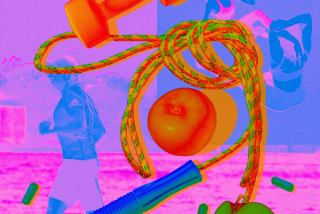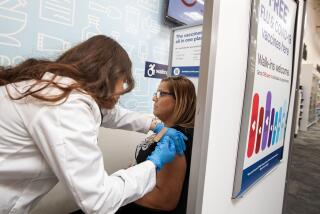Health and Nutrition : Fat, Sodium in ‘Lite’ Dinners Questioned
- Share via
Frozen diet meals--increasingly the dinner choice of many weight-conscious but busy Americans--deliver their promise of low calories.
But many are too high in fat and sodium, warns the Center for Science in the Public Interest. The Washington-based nonprofit consumer advocacy group recently compared nutritional content of frozen dinners, including so-called “light” offerings, and plans to publish the results in its January/February Nutrition Action Healthletter, expected to be in subscribers’ homes by mid-January.
On the average, six frozen diet dinner lines were found to have a low enough fat content (less than 30% of calories from fat) to be classified as lean by CSPI, according to Bonnie Liebman, the organization’s director of nutrition and author of the newsletter article. CSPI used nutritional information supplied by manufacturers, she said.
Six Classified as ‘Lean’
Benihana Lite Dinners, with 14% of their calories from fat, won the No.1 spot. Other offerings classified as lean, and their average percentage of calories from fat: Light & Elegant, 18%; Armour Dinner Classics Lite, 23%; Le Menu Light Style Dinners, 25%; Mrs. Paul’s Light Seafood, 26%, and Stouffer Lean Cuisine, 28%.
Three lines of “light” dinners surveyed averaged more than 30% of calories from fat, including Budget Gourmet-Slim Selects (32%), Legume Light Tofu Entrees (35%) and Weight Watchers (38%).
(Keeping total daily fat intake to less than 30% of calories, protein intake to 15% and carbohydrate intake to 50% or 55% is recommended by the American Heart Assn. and many nutritionists.)
“Averages don’t tell the whole story,” Liebman said. “You must read labels. For example, half of the Lean Cuisine items have less than 30% fat; half have more. Eight of the Weight Watchers items have 30% or less fat; the rest have more.”
Fat contents are only part of the story. Many frozen diet dinners that won CSPI’s nod for trimming fat failed its salt test.
Benihana Lite Dinners average 1,096 milligrams of sodium. (A daily intake of 1,100 to 3,300 milligrams of sodium is recommended by nutritionists.) “By the time you consume a day’s worth of calories (say 1,600 to 2,400), you’re virtually guaranteed to overshoot the 1,100 to 3,300 milligrams of sodium recommended for a whole day (with the high-sodium dinners),” Liebman notes in the article. Light & Elegant averages 859 milligrams of sodium per dinner; Armour Dinner Classic Lites average 871, Le Menu Light Style Dinners average 680; Mrs. Paul’s Light Seafood averages 796 and Stouffer’s Lean Cuisine 934.
‘Seafood With Salt’
One of the Armour offerings, Seafood with Natural Herbs, “should have been called ‘Seafood With Salt,’ the newsletter notes. “Thanks to the imitation shellfish made from surimi (a fish paste), it packs 1,400 milligrams of sodium.”
Legume Light Tofu Entrees, however, average only 354 milligrams of sodium, Liebman pointed out, “proving that TV dinners don’t have to be high in salt.”
The frozen diet dinners can have other problems as well, noted Leslie Eckerling, a Tustin registered dietitian and president of L.I.T.E. Nutrition. “With a lot of them, the taste is not what you want it to be. And fiber contents are low.”
Despite their nutritional shortcomings, frozen diet dinners can have a place in a weight-conscious consumer’s diet, Liebman and Eckerling agreed. “Frozen diet dinners are probably better than eating in fast-food restaurants,” Liebman said. “They’re better than a Big Mac or Chicken McNuggets, but they’re not perfect.”
“I advise people (who like frozen diet dinners) to use them occasionally,” Eckerling said.
Consumers can improve the nutritional value of frozen diet dinners in a number of ways, agreed Liebman and Eckerling:
--Choose dinners with a relatively low fat content, Liebman suggested. “If a label lists fewer than 10 grams of fat, it should mean that less than 30% of its calories come from fat,” she explained.
--Choose dinners with the lowest possible sodium level. On days when frozen diet dinners are eaten, cut back on salt at other meals, Liebman suggested.
--Balance the frozen dinner nutritionally. “Look for ones with side dishes,” Eckerling advised. Or balance it yourself, Liebman advised, by adding steamed broccoli or a dark green salad with carrot and tomato. Low-fat yogurt for dessert (for its calcium content) is another good idea, Liebman said.
--Watch out for what Liebman says is a common frozen diet dinner trap: “Don’t say, ‘I’ve had my low-calorie frozen dinner; now I’ll have apple pie.’ ”
Flu Season
Jan. 1 doesn’t just open a new year. It’s also the peak of the flu season.
“In Los Angeles, the height of the flu season is from mid-December to about April 1,” said Dr. Jerrold Rotwein, chief of urgent-care services at Kaiser Permanente Medical Center, Hollywood.
This season, two strains predominate, according to Nancy Arden, an epidemiologist at the Centers for Disease Control: A/Leningrad and B/Ann Arbor.
Both can come on within a matter of hours, Rotwein said, and symptoms can include headache, an achy feeling, fatigue, sore throat, a temperature of 99-101 degrees Fahrenheit and dry cough, Rotwein said. When flu does strike, Rotwein recommends drinking plenty of fluids and resting. Adults may take aspirin; children and teen-agers should be given acetaminophen to avoid the risk of Reye’s syndrome, a sometimes fatal childhood disease associated with aspirin use. “Stay away from crowds to reduce further exposure (to the flu virus),” he said.
No ‘Quick Fix’ Exists
Patience is important too, Rotwein said. “Everybody wants a quick fix,” he said, emphasizing that none exists.
Flu sufferers should think about seeking professional medical help, Rotwein said, if fever is high (more than 102 degrees) for more than two or three days. (In children, parents may want to consult their physician sooner, he said.) If a fever subsides and reappears, Arden said, calling the doctor is also a good idea.
A “productive” cough--one in which much sputum is produced--is another reason to obtain professional medical help, Arden added, because it may mean that pneumonia or bronchitis is developing.
An anti-viral prescription drug, amantadine (Symmetrel) is sometimes given as a preventive measure, especially in high-risk populations such as nursing homes, Rotwein said. But it’s not in widespread use, he said, because undesirable side effects such as balance problems can occur.
It’s a bit late this season for the preventive approach of flu shots, he added. “The best time for flu shots is September and October, because it takes (about) a month to build immunity,” Rotwein said. “But it’s OK to get one now,” he added. If someone is concerned about contracting the flu, he said, obtaining a flu shot up until Friday may do some good.
Not everyone needs a flu shot, he and other experts say. “Flu shots in my opinion are not recommended for any healthy person under age 50,” Rotwein said, with the exception of those working in the health-care field. “I recommend flu shots for anyone age 55-60 who wants it and anyone under that age with a significant medical problem such as AIDS, diabetes, or heart, lung or kidney problems.” People allergic to eggs or who have febrile illness should not get the flu shot, he added.
More to Read
Eat your way across L.A.
Get our weekly Tasting Notes newsletter for reviews, news and more.
You may occasionally receive promotional content from the Los Angeles Times.









